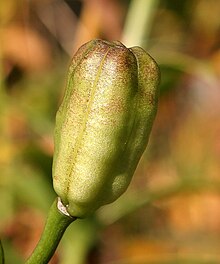Aggregate fruits
 Detail of the raspberry flower: there is a clustering of pistils at the center of the flower. (A pistil consists of stigma, style, and ovary.) The stigma is the apical (at the apex) nodule that receives pollen; the style is the stem-like column that extends down to the ovary, which is the basal part that contains the seed-forming ovule.
Detail of the raspberry flower: there is a clustering of pistils at the center of the flower. (A pistil consists of stigma, style, and ovary.) The stigma is the apical (at the apex) nodule that receives pollen; the style is the stem-like column that extends down to the ovary, which is the basal part that contains the seed-forming ovule.  Lilium unripe capsule fruit; an aggregate fruit.
Lilium unripe capsule fruit; an aggregate fruit. An aggregate fruit is also called an aggregation, or etaerio; it develops from a single flower that presents numerous simple pistils.[16] Each pistil contains one carpel; together, they form a fruitlet. The ultimate (fruiting) development of the aggregation of pistils is called an aggregate fruit, etaerio fruit, or simply an etaerio.
Different types of aggregate fruits can produce different etaerios, such as achenes, drupelets, follicles, and berries.
- For example, the Ranunculaceae species, including Clematis and Ranunculus, produces an etaerio of achenes;
- Rubus species, including raspberry: an etaerio of drupelets;
- Calotropis species: an etaerio of follicles fruit;
- Annona species: an etaerio of berries.[23][24]
Some other broadly recognized species and their etaerios (or aggregations) are:
- Teasel; fruit is an aggregation of cypselas.
- Tuliptree; fruit is an aggregation of samaras.
- Magnolia and peony; fruit is an aggregation of follicles.
- American sweet gum; fruit is an aggregation of capsules.
- Sycamore; fruit is an aggregation of achenes.
The pistils of the raspberry are called drupelets because each pistil is like a small drupe attached to the receptacle. In some bramble fruits, such as blackberry, the receptacle, an accessory part, elongates and then develops as part of the fruit, making the blackberry an aggregate-accessory fruit.[25] The strawberry is also an aggregate-accessory fruit, of which the seeds are contained in the achenes.[26] Notably in all these examples, the fruit develops from a single flower, with numerous pistils.
Multiple fruits
A multiple fruit is formed from a cluster of flowers, (a 'multiple' of flowers) – also called an inflorescence. Each ('smallish') flower produces a single fruitlet, which, as all develop, all merge into one mass of fruit.[27] Examples include pineapple, fig, mulberry, Osage orange, and breadfruit. An inflorescence (a cluster) of white flowers, called a head, is produced first. After fertilization, each flower in the cluster develops into a drupe; as the drupes expand, they develop as a connate organ, merging into a multiple fleshy fruit called a syncarp.
Progressive stages of multiple flowering and fruit development can be observed on a single branch of the Indian mulberry, or noni. During the sequence of development, a progression of second, third, and more inflorescences are initiated in turn at the head of the branch or stem.
Accessory fruit forms
Fruits may incorporate tissues derived from other floral parts besides the ovary, including the receptacle, hypanthium, petals, or sepals. Accessory fruits occur in all three classes of fruit development – simple, aggregate, and multiple. Accessory fruits are frequently designated by the hyphenated term showing both characters. For example, a pineapple is a multiple-accessory fruit, a blackberry is an aggregate-accessory fruit, and an apple is a simple-accessory fruit.
You received this message because you are subscribed to the Google Groups "1top-oldtattoo-1" group.
To unsubscribe from this group and stop receiving emails from it, send an email to 1top-oldtattoo-1+unsubscribe@googlegroups.com.
To view this discussion on the web visit https://groups.google.com/d/msgid/1top-oldtattoo-1/CAGNPKmnTtJjz4qxLHtEdhLiVyE%3Dx743Qzn59NkFM36sJWrkuAg%40mail.gmail.com.

No comments:
Post a Comment